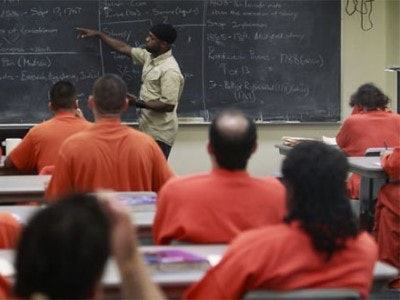WASHINGTON — Up until now, much of the talk about the Obama Administration’s Second Chance Pell Pilot Initiative has been about the merits of providing higher education to individuals behind bars.
But at the inaugural convening of the initiative Tuesday, representatives from the 69 colleges and universities selected last month to participate in the pilot began to delve into the nitty-gritty of how the program is supposed to work.

Topics at Tuesday’s event — convened by the New York-based Vera Institute of Justice — ranged from how to disburse financial aid within a correctional setting (not directly to the inmates, one official said) to criteria of what offenses might preclude a prisoner from obtaining a Pell Grant. There were also practical warnings about how cookies may constitute contraband (they could send diabetic inmates into a diabetic coma, one correctional officer said) and how to deal with “love notes” from inmates.
Despite prior research that shows inmates who enroll in correctional education programs are less likely to reoffend, one of the most important topics discussed at Tuesday’s convening was the need for rigorous evaluation of the Second Chance Pell Pilot programs in order to establish an evidence base for what works.
“Policymakers need a more sophisticated understanding of how certain programs work or don’t work,” said Johan Uvin, acting assistant secretary in the Office of Career, Technical, and Adult Education within the U.S. Department of Education.
Among other things, Uvin said there is a need for more information about what kind of employment participants in correctional education secure upon their release from prison and what kind of money they earn.
Some attendees asked how much of a challenge it will be to track ex-offenders’ employment and earnings after release.
“If it’s on the books, we can access Unemployment Insurance data,” said Nancy La Vigne, director of the Justice Policy Center at the Urban Institute. “But if it’s off the books, it’s more labor intensive but it is possible.”
Angela Hawken, associate professor of public policy at Pepperdine University and founder and director of BetaGov — an agency that helps practitioners evaluate their programs for free — said BetaGov is interested in seeing Second Chance Pell Pilot programs run by people who have a “taste for innovation.”
“We don’t care what it is,” Hawken said. “But we’re interested in those who are trying something new.”
She suggested, for instance, that trying out “congregative cohorts” might show that prisoners do better when they are housed in separate units where all the inmates have a common interest in education.
“How do you create the feel of a college campus within a facility?” Hawken asked during a panel discussion about how participants can collaborate with independent researchers to evaluate their postsecondary correctional programs.
She cautioned, however, that just because something works at one correctional facility does not mean that it will necessarily work at another.
“Institutional culture matters,” Hawken said.
Michael Capra, superintendent at Sing Sing Correctional Facility in New York State, said that shaping institutional culture involves prisoners and guards alike.
“We have to be able to change the culture not only with the inmate population but with our staff,” Capra said.
Several formerly incarcerated individuals spoke about their college experience in prison and the challenges they face upon release.
Ivelisse Bibi Gilestra, who served 13 years of a 15-year sentence and earned an associate’s degree in prison through NJ STEP — an acronym fro the New Jersey Scholarship and Transformative Education in Prisons Consortium — said inside prison, a sense of community and consistency are the most important things that students need.
Once free, she said, the challenge is helping formerly incarcerated individuals learn how to manage their freedom.
Of her experience enrolling in Rutgers after her release, she said she often felt like “Now what?
“I had to learn to make decisions again, because prison is so structured, it does that to you,” Gilestra said.
Sean Pica, executive director of the Hudson Link for Higher Education, said it’s important for college instructors in correctional settings to be of high quality and not think they just can perform at a mediocre level because they are teaching prisoners.
“We want the same rigor and quality as there would be on campus,” Pica said.
At a panel on how to support quality education in prison, Pica related that he had just fired an instructor minutes prior, telling him, “I’m sorry but your services are no longer needed.”
Jamaal Abdul-Alim can be reached at [email protected] or follow him on Twitter @dcwriter360.





















